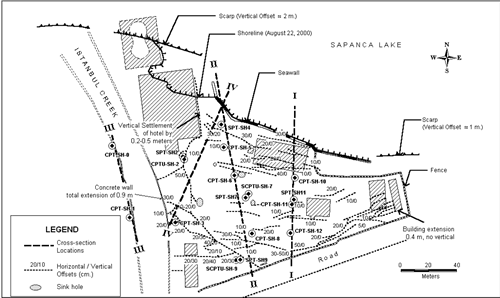| Project Title/ID Number |
Improved Assessment of
Liquefaction-Induced Lateral Spreading Hazard—3G02 |
| Start/End Dates |
6/1/03 – 5/31/04 |
| Project Leader |
Raymond Seed (UCB/F) |
| Team Members |
Allison Faris (UCB/GS) |
F=faculty; GS=graduate student; US=undergraduate student; PD=post-doc; I=industrial
collaborator; O=other
Click on images to enlarge in a new window
1. Project Goals/Objectives:
The goal of this research effort is to use the field case history database
developed in previous year’s efforts regarding liquefaction-induced
lateral spreading, as well as new relationships developed by PEER-supported
laboratory testing programs to better define post-liquefaction strain and
displacement behaviors, to develop improved engineering methods for estimation/prediction
of lateral spreading deformations. This work has previously been funded
for 2 years by the USGS, and the current PEER Lifelines Program support
covers the third year of what is currently envisioned as a three and a
half year overall effort.
2.
Role of this project in supporting PEER’s mission
(vision):
Development of improved, and formally probabilistically based, methods
for prediction of liquefaction-induced ground deformations and displacements
is a high priority within the Lifelines Program, as it affects all types
of structures and distributed systems. We are currently generally well
able to accurately predict the likelihood of “triggering” or
initiation of liquefaction, but are generally lacking with regard to
analytical tools for prediction of the ensuing consequences in terms
of post-liquefaction stability and liquefaction-induced deformations.
This project addresses one of the most dramatic types of liquefaction-induced
deformation modes: lateral ground spreading.
3. Methodology Employed:
The approach is to back-analyze the world’s accumulated database
of field case histories of liquefaction-induced lateral spreading, and
then to use Bayesian Updating (regression) methods to develop empirical
predictive tools for prediction of future lateral spreads. What makes
this project different from previous efforts are:
-
The use of post-liquefaction
strain potential (a new concept) as the principal index of soil resistance
to deformations,
-
The use of significantly improved characterization of
both seismic loading and gravitational driving forces, and
-
The use of
higher-order probabilistic regression methods able to accurately
track and deal with covariance’s between variables as well as with
the multiple sources of uncertainty inherent in these field case
studies.
4. Brief Description of past year’s accomplishments
(Year 6) & more detail on expected Year 7 accomplishments:
The bulk of the past year has been spent processing and analyzing field
performance case histories, and in reviewing the interpretations of these
with various experts. An initial framework and mathematical model for the
proposed Bayesian regression has also been established, but numerous potential
options continue to persist here, and the final form of the regressions
are not yet clear.

Figure 1: Ground Deformation Measurements and Locations of Borings and CPT
Probes at the Hotel Sapanca Site, Turkey
5. Other Similar Work Being Conducted Within and Outside
PEER and How This Project Differs:
There is no similar work currently in progress.
6. Plans for Year 8 if project is expected to be continued:
Year funds have been banked from USGS sources, and the bulk of the probabilistic
regression analyses will be performed over the next roughly six months.
7. Describe any actual instances where you are aware your
results have been used in industry:
None as yet.
8. Expected Milestones & Deliverables:
Target for December 2004:
-
Formally probabilistically based empirical/analytical
methods for prediction of liquefaction-induced lateral spreading displacements
and deformations.
-
Edited, vetted and interpreted/analyzed suite of field
performance case histories, documenting all key data and associated sources.
-
A
new “strain potential” basis for estimation of deviatoric
liquefaction-induced ground deformations, to complement a similar (recent)
volumetric strain potential approach for assessment of post-liquefaction
volumetric ground settlements.
